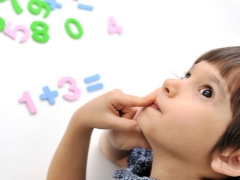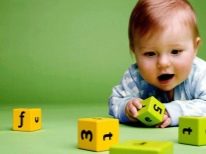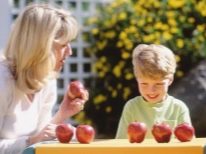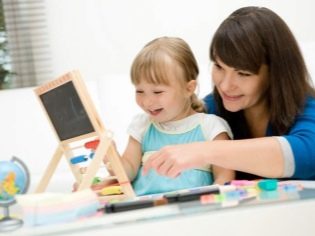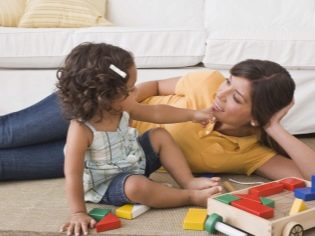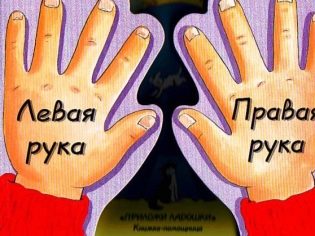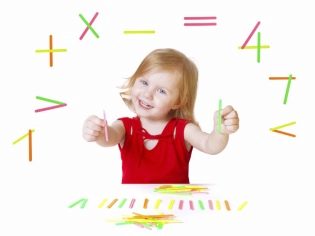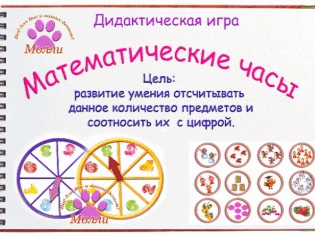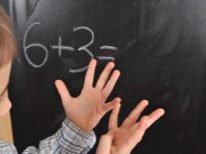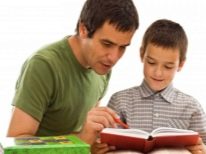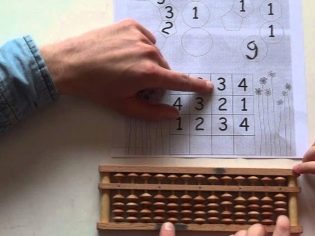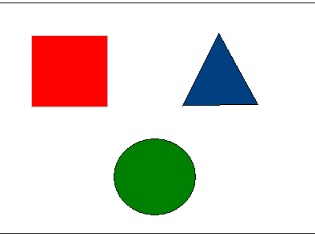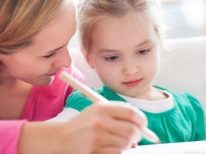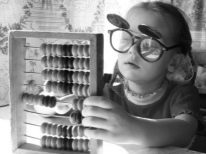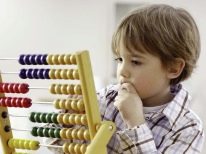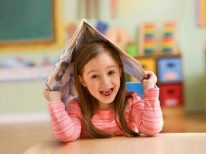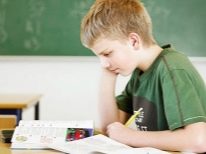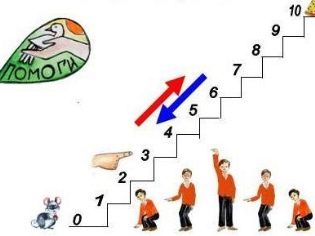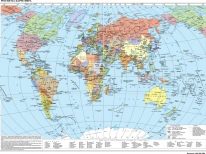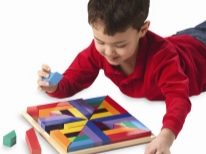How to teach a child to count?
Reading, writing, counting are the basic skills needed to master a child’s knowledge, so they need to be worked out from an early age and not wait for the kid to go to school. Having taught a crumb to read, write and count, you will greatly facilitate his life in an educational institution. One of the most difficult tasks can be learning the account, but do not be afraid and give up on failure: the main thing is patience and work.
Features of training
The attention of a small child is difficult to focus on something serious. Begin training should be in the form of a game to interest the crumbs. It is not necessary to sit with the baby at the table, as if at a school desk. You can learn in different ways: moving, sitting on the floor, even jumping on the spot.
With children of preschool age, you can start more serious, requiring concentration classes. The time spent on the bill may also increase. For example, it is advisable to engage with babies for 10 minutes about three times a day. With preschool children - 20 (30 minutes at best).
Teaching a child to count will be easier if you rely on a few simple rules:
- Create a favorable atmosphere. With screams, you will not achieve anything, just discourage the child from learning to learn. In this case, patience and peace are important factors.
- Connect to learning the surrounding objects, show your child that the ability to count is vital. You can count the plates on the table, birds flying in the park, children on the playground, fruits, cars, toys, stairs in the stairwell, and much more.
- Do not demand more from a small child than he can. All children are individual in their development, each new skill comes in its own time.
If the baby does not work, do not be annoyed. Wait, return to the task after some time (for example, in a week, month).
- When learning, try to follow three steps. First, let the baby get used to the names, terms, the process itself. Then make sure that he understands the essence of the subject. Simple memorization is irrational, it is necessary that the child learns to understand, to be aware of the essence of each phenomenon. When the information is understood by the child, he can retell and explain it, then you can proceed to memorization.
- Do not forget that when you get acquainted with mathematics it is worth paying attention not only to the account. You can also teach the crumb to recognize geometric shapes, orient yourself in space so that he can show where the “top”, “bottom”, “right”, and “left” are. By about three years old, the baby should be able to determine which object is shorter, longer, higher, lower, in which direction it is going.
Considering age
Children learn something new much easier than adults. The need to obtain new knowledge arises in children by the age of two. Fresh information is given to kids without effort, so they quickly learn to some kind of action. But when teaching an account, the child’s age should be considered:
- Begin to teach can be considered in 2 years. During this period, children are able to master the score from 0 to 3. By the age of 2.5-3, you can train the score to 10. All this must be done with visual aids, objects, improvised means (for example, using dice, sticks).
- In 3-4 years the child is able to learn to count to 20. At this stage, visibility is still needed: it is worth using cards with numbers, objects that need to be counted.
- If a kid has a mathematical mindset, in 4-5 years he can learn to count to 100.The main thing is to explain the principle of forming numbers from numbers. Do not despair, if at this age your child is not given an account with dozens. You can resume training in 6 years.
- At the age of 5-6 years you need to move from visualization to mental arithmetic. During this period, the child must learn to count without the help of sticks, fingers, cards. You need to train the countdown and also call the numbers in a chaotic order.
Addition and subtraction
The ability to add and subtract is produced usually by five years. First, it should be done with the help of various items, then train to solve the simplest examples in the mind. When training for the account, it is gradually necessary to introduce simple examples of addition and subtraction. It is still early to solve examples with a column, but it is quite possible to teach unambiguous numbers.
Doing math with a child is necessary so that he does not lose interest. Therefore, no boring examples like “3 + 5 =? " it can not be. We learn, enticing, clearly. It is possible in the comic form.
Need to start with a simple. For example, add a unit to each known digit and subtract it. It is worth using the objects interesting to the child or important for him. An example is better to present in the form of a question: “You have two cookies. One you will share with mom. How much will you have? "And all in the same spirit.
To proceed to the subtraction, make sure that the baby is well mastered addition. Use the examples of addition and subtraction not only in the classroom, but also on a walk, in the store, at lunch, when cleaning the room. Let the child pronounces the task condition after you. Use special aids and didactic materials with simple exercises. Pay attention to the presence of vivid illustrations. Do not forget - you need to lure the child.
To easily add and subtract, the baby needs to study the composition of the number. He must learn that 5 consists of the numbers 2 and 3, 1 and 4, 10 - from the numbers 1 and 9, 2 and 8 and so on. Before you learn how to count in your mind correctly, a child should solve problems with visual materials or on fingers well. It is better to start learning account training from the age of 4, not earlier. From this age, the time allotted for addition and subtraction affects the overall development.
It is important to learn the concepts of “more”, “less”. Scrolling through the training books, you can ask what animals on the page more, what color less. You also need to learn the term "equally". It is necessary to explain to the child that the sum does not change from the change of places of the components.
We can not miss the opportunity to ask the baby to count in your mind. This can be done anytime, anywhere, with anything: you can count at home, benches, flowers, chairs.
Impact on development
At 5-6 years old, most preschoolers already know how to count decently up to 20, or even up to 100. Learning to count specifically and mathematics generally contributes to the intellectual development of the child as a whole. A mental score stimulates the brain, makes it tense. Memorization of numbers, their composition develop memory.
Solving simple tasks, where you need to calculate, add or subtract any objects, the kid connects his imagination, drawing various images in his head. Speaking the conditions of the problem out loud, the child trains the speech. Therefore, it is important that adults pronounce the text correctly, because the crumb will repeat it.
Knowing the numbers will give the child the opportunity to participate to some extent in the life of adults: he will be able to help set the table, knowing how many cutlery you need, carry out small tasks from parents, which will accustom him to responsibility and much more. This is a good preparation for school. Already in the first grade, the child will be able to count how many children are present at the lesson, to call the date, he will know what it means to “prepare two pencils for work”.
Quick techniques
Training should be done gradually. First you need to learn the numbers from 0 to 10. But this is also difficult for the baby. Therefore, crush the top ten, for example, into two fives and learn in stages.For training, you can use a variety of teaching aids, connect interesting material (games, fairy tales, counting notes), make your lessons fun, while avoiding boring learning.
At home you can easily diversify the learning process:
- learn to count on the fingers;
- choose tasks in the form of games;
- connect the counters;
- show pictures, asking how many items are shown;
- view educational programs with your baby;
- teach poetry and fairy tales with numbers and ordinal numbers with your child;
- constantly consider everything that comes your way.
The following methods and rules for teaching preschoolers are suggested. You can choose the most suitable method for your child. It is better to combine several.
Methodology Sergei Polyakov
According to this method, it is necessary to begin to teach a child the account when he is interested. As soon as parents notice that the baby is interested in numbers, learning should begin. Not later than. Sergey Polyakov does not recommend using the account training method, at which one should be added. This slows down the learning process, prevents the child from developing.
He does not recommend starting the training with an account on sticks, fingers and a ruler. It also does not contribute to intellectual development. According to Polyakov, the lessons are based on oral account training. First, the baby lists everything that comes across his eyes (toys, books, stairs), then he tries to count to himself, including folding and subtracting.
At the first stage, the child works with numbers within 10. To solve simple examples in mind, the child needs to remember the composition of numbers. At the second stage, the child solves examples already with double digits. At the same time, he does not extract ready-made solutions from memory, as it happens at the first stage, but comes to understanding and memorizing the methods of addition and subtraction.
When learning, the child must learn the concepts of “more”, “less”, “equal”. The lessons on the Polyakov method are accompanied by various games. For example, at the first stage they use cubes and games with them “Putting the numbers to the cubes”, “Gnomes in the house”, “Divide in half”. You can use others.
Peterson technique
The technique of Lyudmila Georgievna Peterson teaches children to think logically. The method is not limited to learning the account, it includes many interesting game tasks that develop ingenuity. This technique is popular in preschool and primary schools. The learning system is a cycle, which is called the "puff pie principle".
Traditional teaching methods adhere to a linear concept: in the first class, we study addition and subtraction, in the second - the multiplication table, division and multiplication, in the third - fractions, and so on. It turns out that if the child was ill for a long time in the second grade and missed the main points of the topic, it will be difficult to catch up. Following this technique each year the same thing is studied, but with different depth of complexity. For several years in a row, the themes have been repeated, with each again and again appearing in a new aspect.
This system involves a large number of games. Kids, for example, like the numeric beam. Before the crumbs is the task: find out how much will be 3 + 2 The child rises to the mark 3, takes two steps forward (needs to be added) and stops at the mark 5. If you need to subtract, the child takes 2 steps back. So baby gradually remembers the composition of single numbers.
At home, you can develop the logic of the baby, playing. You lay a row of cubes: 2 red-2 blue, 2 red-2 blue. Tell the child to continue the series so that the sequence is not disturbed. If a crumb takes instead of a red cube, for example, yellow, you suggest that the series changes this way, but it must be preserved.
Another interesting game. Draw a large blue square on a sheet of paper. You give the child a task - to draw a figure that differs from yours only on one basis. Your child draws a small blue square.Then you draw a little blue circle. He is a little yellow circle. And so on to infinity, until you get bored.
It is appropriate to use tasks with the definition of a larger and smaller number of objects. In two squares located opposite each other, you need to draw, for example, hearts - 6 and 5. The baby needs to determine where it is more. Of course, he immediately rushes to count the hearts. But you can show him another way.
Show that the hearts are combined in pairs: you connect one heart from the left square with a line to a heart from the right square. In the square where the heart was left without a pair, there are more of them. Here you can enter the signs "more" and "less." It happens that there is not enough time to study with the child and draw tasks for him.
According to this method, many printed notebooks are produced with interesting tasks that you can take a child.
Zaitsev Training
Nikolai Aleksandrovich Zaitsev has developed several games and sets of visual materials that facilitate the learning of mathematics. For example, the game "Hundred Score". It includes a set of cards with numbers in front of 100. This game will help develop the child.
Each card shows one number. In addition to numbers, geometric figures in the number of tens and number units are depicted. For example, the number is 75. Under the seven is depicted a row of seven rectangles, each with ten sticks (7 dozen), and under the five - 1 with five sticks (5 units).
Gradually, the child must be introduced to each card, you can arrange them on the wall in the nursery. On the same cards you can learn to add and subtract. The Zaitsev methodology also includes such games as “I Am Close in Hundreds” (studying numbers up to a thousand), “Platonic Solids” (geometric skills), “Thousand Plus”, etc.
School Soroban
Mental arithmetic Soroban - the school of oral accounts in the mind. These are official institutions located in several cities of Russia that teach children under this program. School Soroban builds classes so that both hemispheres of the brain are involved. At the same time they form various skills:
- speech;
- imagination;
- creative thinking;
- analytical thinking;
- memory;
- Creative skills;
- Attention;
- intuition.
Training takes place on the accounts. The emphasis is on seeing and remembering the picture in motion. Then the child himself creates moving images, creates associations. This technique creates conditions for the rapid perception of information, teaches to synthesize and analyze information, contributes to a quick mental calculation.
Under this program, children from 5 to 11 years old can study.
Technique of the school Soroban is built on three basic principles:
- regularity;
- fascinating learning process;
- strong motivation.
Until recently, the method of school Soroban worked well only with gifted children. With the guys of the average level of development classes did not work, seemed too difficult.
In recent years, the school has developed a program that is suitable not only for “geeks”, but also for children with average abilities, which allows them to learn something more, develop average abilities to high results.
By any method chosen, one can and should be taught counting. First, for this you should use visual material (the same cubes, cards, toys). Then it is important to accustom to the counting out loud, but without the improvised items. Do not forget about the ordinal score.
Education can be carried out by telling a fairy tale. For example, "Teremok" ("The first mouse came, the second - the frog ...", etc.). Then you need to ask questions to the baby (who was the first, second, third). You can ask him to retell the tale using ordinal numbers.
Now it is customary in schools to build combined lessons with interdisciplinary communication. For example, in a lesson in mathematics, you can use material from history, literature, geography, and other academic subjects. When training an account at home, you can also use other disciplines.
In a biology textbook, say, an older brother or sister, it would be nice to count the organs in the human body, on the world map - the number of continents (connection to geography). You can sing songs with numbers (connection to music), read syllables in words (connection to Russian).
After a series of homework with the baby, arrange him a small test in the form of a test. And depending on how he copes with it, award a small prize. There should always be a stimulating component in the training. Do not forget about the account in everyday life.
Which method is better?
The most effective method is the one that suits the child, taking into account his individual characteristics. You may have read or heard about some super-productive method, but it does not give fruit to your child. Do not torture yourself and the child: try something different, less complicated. In the process of learning you need to face it - not all children develop quickly, not all of them are gifted, the tasks for everyone must be chosen according to their strengths.
In any method, use the game to maintain the interest of the child and the connection with everyday life.
With preschoolers need to be engaged in so as to prepare for school. And these are not only numbers, the score is 1, 2, 3, 4, addition and subtraction. Preschoolers need to develop logic, analytical thinking. They must learn to think, search for a solution to the problem on their own, make assumptions, and not just extract a memorized, prepared answer from memory. Although in many situations and without it anywhere.
By the beginning of the first class, the child must know the score to at least 20 (preferably up to 100), be able to work in the mind with single and double digits. Must know where the "right", "left", "top", "bottom", which means "more", "less", "equal".
No account on the fingers should not be. It is important that actions are carried out only in the mind. Therefore, choose the appropriate method. Any of the above will work.
Despite the importance of achieving a result, do not go to the classroom at the cry, do not scold and do not punish the child, if any task is beyond its power. The desire to work in this case, you will not return, and everything will collapse.
Baby should enjoy the lessons. Well, if they will cause joy while waiting before they begin, and not the horror of the upcoming torture.
For more information on how to teach a child to count, see the following video.
